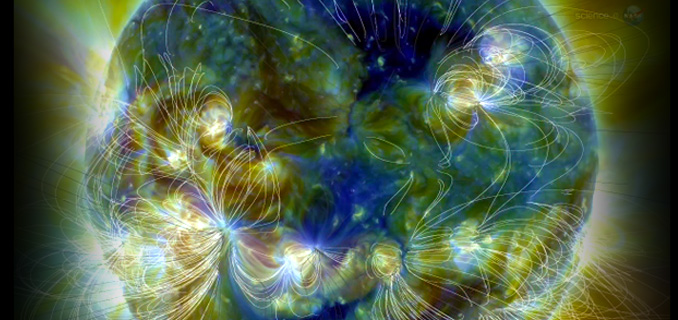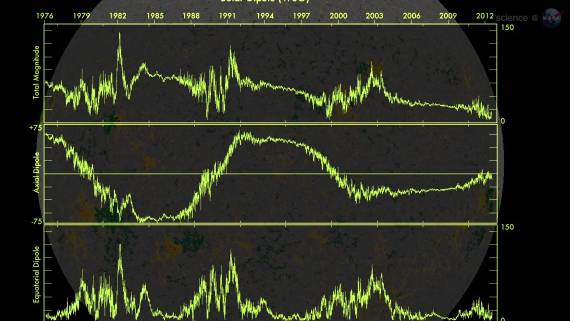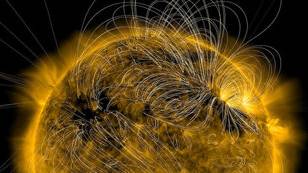NASA: The Sun’s Magnetic Field is about to Flip
Source: science.nasa.gov

Something big is about to happen on the sun. According to measurements from NASA-supported observatories, the sun’s vast magnetic field is about to flip.
"It looks like we’re no more than 3 to 4 months away from a complete field reversal," says solar physicist Todd Hoeksema of Stanford University. "This change will have ripple effects throughout the solar system."
The sun’s magnetic field changes polarity approximately every 11 years. It happens at the peak of each solar cycle as the sun’s inner magnetic dynamo re-organizes itself. The coming reversal will mark the midpoint of Solar Cycle 24. Half of ’Solar Max’ will be behind us, with half yet to come.
Hoeksema is the director of Stanford’s Wilcox Solar Observatory, one of the few observatories in the world that monitor the sun’s polar magnetic fields. The poles are a herald of change. Just as Earth scientists watch our planet’s polar regions for signs of climate change, solar physicists do the same thing for the sun. Magnetograms at Wilcox have been tracking the sun’s polar magnetism since 1976, and they have recorded three grand reversals—with a fourth in the offing.
Solar physicist Phil Scherrer, also at Stanford, describes what happens: "The sun’s polar magnetic fields weaken, go to zero, and then emerge again with the opposite polarity. This is a regular part of the solar cycle."
A reversal of the sun’s magnetic field is, literally, a big event. The domain of the sun’s magnetic influence (also known as the "heliosphere") extends billions of kilometers beyond Pluto. Changes to the field’s polarity ripple all the way out to the Voyager probes, on the doorstep of interstellar space.

When solar physicists talk about solar field reversals, their conversation often centers on the "current sheet." The current sheet is a sprawling surface jutting outward from the sun’s equator where the sun’s slowly-rotating magnetic field induces an electrical current. The current itself is small, only one ten-billionth of an amp per square meter (0.0000000001 amps/m2), but there’s a lot of it: the amperage flows through a region 10,000 km thick and billions of kilometers wide. Electrically speaking, the entire heliosphere is organized around this enormous sheet.
During field reversals, the current sheet becomes very wavy. Scherrer likens the undulations to the seams on a baseball. As Earth orbits the sun, we dip in and out of the current sheet. Transitions from one side to another can stir up stormy space weather around our planet.
Cosmic rays are also affected. These are high-energy particles accelerated to nearly light speed by supernova explosions and other violent events in the galaxy. Cosmic rays are a danger to astronauts and space probes, and some researchers say they might affect the cloudiness and climate of Earth. The current sheet acts as a barrier to cosmic rays, deflecting them as they attempt to penetrate the inner solar system. A wavy, crinkly sheet acts as a better shield against these energetic particles from deep space.
As the field reversal approaches, data from Wilcox show that the sun’s two hemispheres are out of synch.
"The sun’s north pole has already changed sign, while the south pole is racing to catch up," says Scherrer. "Soon, however, both poles will be reversed, and the second half of Solar Max will be underway."
When that happens, Hoeksema and Scherrer will share the news with their colleagues and the public.
Article from: nasa.gov
Tune into Red Ice Radio:
Jay Weidner, Barbara Hand Clow & Lawrence E. Joseph - 2012 Roundtable Special
Will Hart - Solar Flare Apocalypse, Accelerated Natural Disasters & Evolution
Paul A. LaViolette - Earth Under Fire, Galactic Superwaves & Subquantum Kinetics
Micheal Sunanda - Extreme Weather, Global Warming & Permaculture
Robert Schoch - The Mystery of the Sphinx, Forgotten Civilization & Catastrophic Solar Outbursts
Matthew Stein - Hour 1 - When Technology Fails & Six Civilization Busters
Matthew Stein - Hour 2 - 400 Chernobyls, Super Solar Storms & EMPs
David Talbott - Lightning Scarred Planet Mars & The Electric Sun
Randall Carlson - Hour 1 - Cycles of Catastrophe & Cosmic Patterns
Will Hart - Solar Flare Apocalypse & Comets
David Talbott - Hour 1 - Symbols of an Alien Sky
Troy McLachlan & Theodore Holden - Hour 1 - Cosmos in Collision: Antique Solar System, Neanderthals & Modern Man






















